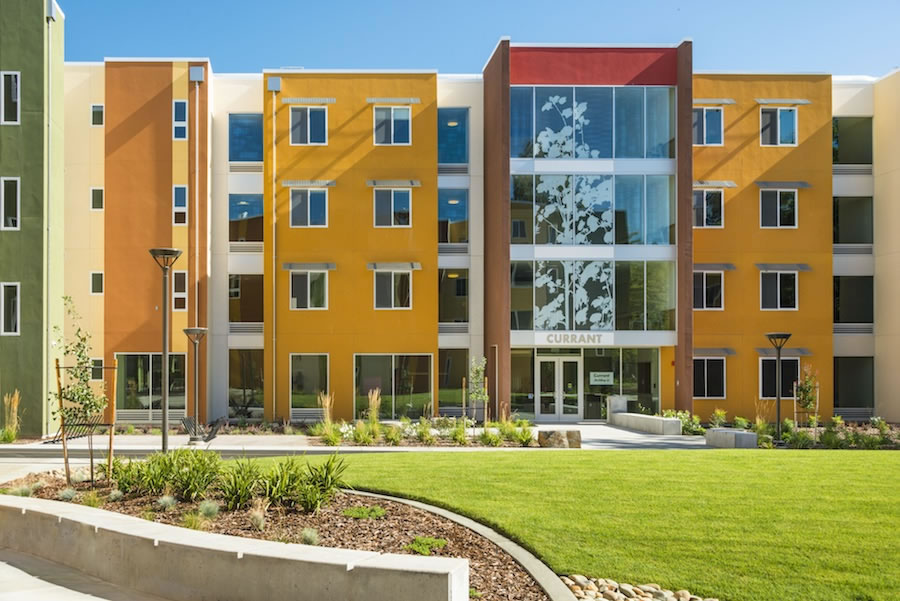The University of California, Davis Tercero 3, student housing built by Sundt Construction and designed by EHDD exceeded its sustainability goals: the project aimed for LEED Gold and wound up achieving LEED Platinum. The $70-million facility spans 320,000 gross square feet across seven, four-story buildings. Multiple lounges, study areas, computer centers, and gathering spaces comprise the complex, which surrounds a picturesque landscaped courtyard.

The floorplan of Tercero 3 was designed to maximize natural light and was created to foster a feeling of community.
PROJECT
LOCATION Davis, CA
Size 320,000 ft 2 Completion July 2014 Certification LEED Platinum
Program Student Housing Cost $70.1 million
TEAM
OWNER UC Davis
Architect EHDD
Civil Engineer Cunningham Engineering
Structural Engineer KPFF Mechanical Engineer Guttmann & Blaevoet
Electrical Engineer Guttmann
& Blaevoet
Lanscape Architect Cunningham Engineering
General Contractor Sundt Construction
SUPPLIERS
Glass Manufacturer Guardian Industries Corp.
Independent Guardian Select Fabricator Hartung Glass – Sacramento
Glazier Montez Glass
Metal Supplier Oldcastle BuildingEnvelope
Roofing Kodiak Roofing Lighting Bergelectric
HVAC Lawson Mechanical
CREATING COMMUNITY
The floorplan of Tercero 3 was designed to maximize natural light and was created to foster a feeling of community by way of “clusters.” Dorm rooms bundle around bathrooms and windowed “porches” with views outside. “The idea is that the dorm cluster is the first community a student will have,” says pre-construction manager Dave Downey. At the end of every corridor, a large floor-to-ceiling window brings in ample daylight. At the main entry, a four-story glass curtainwall system lets light stream into the study rooms and lounge areas, and from a large skylight above the center stairwell, light also pours in from above.
CONDENSING ECONOMIZER
All heat and hot water for Tercero 3 comes from an unlikely source—steam vapor emitted by the campus steam plant. Coils on the boiler stacks divert the plant’s water vapor (previously released into the atmosphere) into a condensing economizer, where heat transfer occurs from the vapor to the water in the pipelines. Two of the pipelines carry water that ends up in the boilers; the third coil is part of a closed loop that carries water between the condensing economizer and Tercero 3, where heat is “exchanged” again— this time from the water in the closed loop to fresh water from the sinks and showers, and to the water supply for the space heating systems. “We were able to take advantage of the plant and capture that energy to essentially get free hot water,” Downey says. The system is saving the university 511,000 therms of natural gas annually, for which the campus earned a $511,000 rebate from Pacific Gas & Electric Co.
BUILDING INFORMATION MODELING
In addition to their extensive top- to-bottom Building Information Modeling, the team also modeled all of the underground utility work. “By modeling everything from the get-go, we were able to confirm that it all was going to fit,” says project manager Shawn Marty. The walls, electrical components, and much of the underground piping were pre-fabricated off-site, which minimized on-site waste and clean-up. “When you prefab in a factory setting, it’s a lot easier to take scraps and repurpose and recycle them pre-consumer,” Marty says.
NATURAL VENTILATION STRATEGIES
Natural ventilation strategies provide fresh air and cooling, eliminating the need for mechanical cooling systems. Under the windows by the stairs on each floor are grilles that let fresh air in. Hot air rises through the central staircase to operable louvers surrounding the skylight that exhaust the extra heat at the top of the stairs. An energy management system mon- itors temperatures inside and out, triggering louvers and fans to assist in natural ventilation throughout the building.

